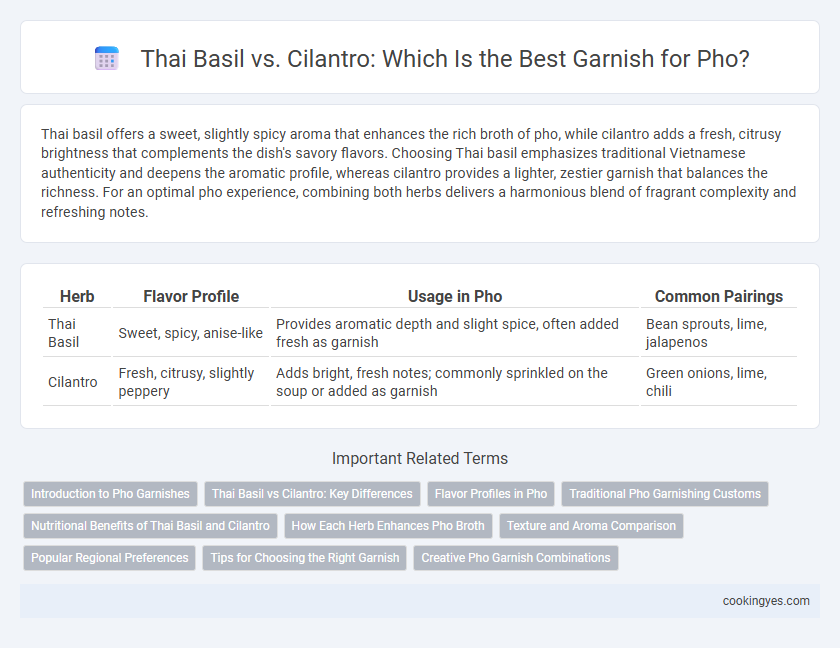Thai basil offers a sweet, slightly spicy aroma that enhances the rich broth of pho, while cilantro adds a fresh, citrusy brightness that complements the dish's savory flavors. Choosing Thai basil emphasizes traditional Vietnamese authenticity and deepens the aromatic profile, whereas cilantro provides a lighter, zestier garnish that balances the richness. For an optimal pho experience, combining both herbs delivers a harmonious blend of fragrant complexity and refreshing notes.
Table of Comparison
| Herb | Flavor Profile | Usage in Pho | Common Pairings |
|---|---|---|---|
| Thai Basil | Sweet, spicy, anise-like | Provides aromatic depth and slight spice, often added fresh as garnish | Bean sprouts, lime, jalapenos |
| Cilantro | Fresh, citrusy, slightly peppery | Adds bright, fresh notes; commonly sprinkled on the soup or added as garnish | Green onions, lime, chili |
Introduction to Pho Garnishes
Pho garnishes play a crucial role in enhancing the soup's aromatic complexity and flavor profile. Thai basil imparts a sweet, slightly spicy aroma with hints of anise, complementing the rich beef broth, while cilantro offers a fresh, citrusy brightness that balances the dish's savory depth. The choice between Thai basil and cilantro allows for personalized flavor layering, essential for authentic pho enjoyment.
Thai Basil vs Cilantro: Key Differences
Thai basil and cilantro are both popular garnishes for pho but offer distinct flavors and aromas; Thai basil provides a sweet, anise-like taste with a slightly spicy undertone, while cilantro offers a fresh, citrusy, and slightly peppery flavor. Thai basil leaves are sturdier and hold up well in hot broth, enhancing pho's rich, savory profile, whereas cilantro's delicate leaves tend to wilt quickly, adding a bright, herbal contrast. Choosing between Thai basil and cilantro can significantly impact the overall flavor balance of pho, as Thai basil intensifies warmth and depth, while cilantro contributes a crisp, refreshing note.
Flavor Profiles in Pho
Thai basil adds a sweet, anise-like flavor with hints of clove that enhances Pho's aromatic broth, creating a robust and slightly spicy taste profile. Cilantro contributes a fresh, citrusy brightness with a subtle earthiness that balances the rich, savory notes of the soup. Combining these herbs offers a layered flavor experience, blending Thai basil's warmth with cilantro's crispness for authentic Pho garnish.
Traditional Pho Garnishing Customs
Traditional Pho garnishing customs emphasize the use of Thai basil over cilantro to preserve authentic Vietnamese flavors, as its aromatic, slightly spicy leaves complement the rich broth. While cilantro offers a fresh, citrusy note, it is less commonly used in classic Pho presentations, which prioritize herbs that enhance the dish's layered taste profile. Vietnamese street vendors and home cooks regularly select Thai basil for its unique ability to balance the savory, umami elements characteristic of Pho.
Nutritional Benefits of Thai Basil and Cilantro
Thai basil contains high levels of vitamin K, which supports blood clotting and bone health, while also providing antioxidants that may help reduce inflammation. Cilantro is rich in vitamin A, vitamin C, and dietary fiber, enhancing immune function and digestive health. Both herbs offer essential nutrients but differ in their unique phytochemical compositions that contribute to overall wellness when added to Pho.
How Each Herb Enhances Pho Broth
Thai basil adds a spicy, anise-like aroma that deepens the savory richness of Pho broth, complementing the star anise and clove spices. Cilantro contributes a fresh, citrusy brightness that cuts through the broth's fatty layers, balancing flavors and enhancing overall complexity. Both herbs elevate Pho by layering distinct herbal notes, but Thai basil emphasizes warmth while cilantro boosts refreshing zest.
Texture and Aroma Comparison
Thai basil offers a slightly crunchy texture with a robust, sweet anise aroma that enhances the broth of pho, while cilantro provides a softer leaf texture and a fresh, citrusy scent that brightens each bite. The contrast in texture between Thai basil's chewy leaves and cilantro's delicate foliage adds complexity to the pho experience. Aroma-wise, Thai basil's spicy notes complement the savory depth, whereas cilantro's crisp fragrance delivers a refreshing balance.
Popular Regional Preferences
Thai basil is the preferred garnish for Pho in Southern Vietnam, where its anise-like flavor complements the rich broth and enhances the dish's aromatic profile. Northern Vietnam favors cilantro for its fresh, citrusy notes that brighten the Pho without overpowering the delicate beef broth. The popularity of Thai basil versus cilantro varies regionally, reflecting local taste preferences and traditional culinary practices in Pho preparation.
Tips for Choosing the Right Garnish
Thai basil enhances pho with its sweet, anise-like flavor and slightly spicy aroma, making it ideal for those seeking a bold garnish. Cilantro offers a fresh, citrusy taste that brightens the broth with its herbaceous notes, perfect for a lighter, cleaner finish. When choosing between Thai basil and cilantro, consider flavor intensity and personal taste preferences to complement pho's rich, savory broth effectively.
Creative Pho Garnish Combinations
Thai basil and cilantro both elevate pho with distinct herbal notes; Thai basil offers a sweet, slightly peppery flavor while cilantro provides a fresh, citrusy brightness. Combining Thai basil with cilantro, thinly sliced jalapenos, and lime wedges creates a vibrant, aromatic garnish that enhances the broth's complexity. For a creative twist, adding crushed roasted peanuts or fried garlic alongside these herbs adds texture and depth, transforming the pho experience.
Thai basil vs cilantro for Pho garnish Infographic

 cookingyes.com
cookingyes.com